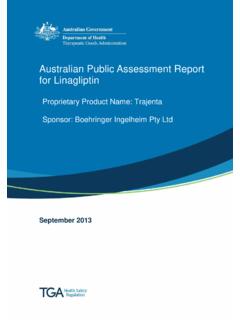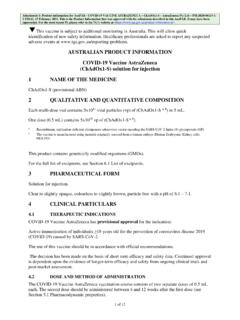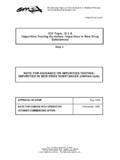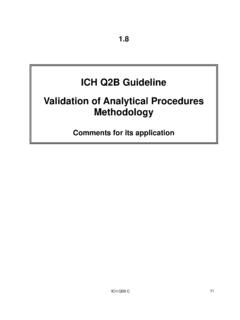Transcription of Guidance 18: Impurities in drug substances and drug …
1 Guidance 18: Impurities in drug substances and drug products Version , August 2013 Therapeutic Goods Administration Guidance 18: Impurities in drug substances and drug products August 2013 Page 2 of 13 About the Therapeutic Goods Administration (TGA) The Therapeutic Goods Administration (TGA) is part of the Australian Government Department of Health and Ageing, and is responsible for regulating medicines and medical devices. The TGA administers the Therapeutic Goods Act 1989 (the Act), applying a risk management approach designed to ensure therapeutic goods supplied in Australia meet acceptable standards of quality, safety and efficacy (performance), when necessary.
2 The work of the TGA is based on applying scientific and clinical expertise to decision-making, to ensure that the benefits to consumers outweigh any risks associated with the use of medicines and medical devices. The TGA relies on the public, healthcare professionals and industry to report problems with medicines or medical devices. TGA investigates reports received by it to determine any necessary regulatory action. To report a problem with a medicine or medical device, please see the information on the TGA website < >. Copyright Commonwealth of Australia 2013 This work is copyright. You may reproduce the whole or part of this work in unaltered form for your own personal use or, if you are part of an organisation, for internal use within your organisation, but only if you or your organisation do not use the reproduction for any commercial purpose and retain this copyright notice and all disclaimer notices as part of that reproduction.
3 Apart from rights to use as permitted by the Copyright Act 1968 or allowed by this copyright notice, all other rights are reserved and you are not allowed to reproduce the whole or any part of this work in any way (electronic or otherwise) without first being given specific written permission from the Commonwealth to do so. Requests and inquiries concerning reproduction and rights are to be sent to the TGA Copyright Officer, Therapeutic Goods Administration, PO Box 100, Woden ACT 2606 or emailed to Therapeutic Goods Administration Guidance 18: Impurities in drug substances and drug products August 2013 Page 3 of 13 Version history Version Description of change Author Effective date Original publication Office of Medicines Authorisation 09/08/2013 Therapeutic Goods Administration Guidance 18.
4 Impurities in drug substances and drug products August 2013 Page 4 of 13 Contents Introduction _____ 5 Impurities in drug substances and drug products 5 Related Impurities in drug substances and drug products _____ 5 guidelines adopted by the TGA _____ 5 Qualification of limits for Impurities ---------------------------------------- --6 Data requirements for qualification ---------------------------------------- --7 Synthetic Impurities versus degradants -------------------------------------8 Impurities in combination products _____ 8 Impurities in synthetic peptides _____ 8 Impurities in fermentation products and semisynthetic derivatives _____ 9 Impurities in biological medicines _____ 9 Impurities relating to mesilates, tosilates, (di)
5 Isetionate and besilates _____ 10 Unrelated Impurities in drug substances and drug products _____ 10 Residual solvents _____ 10 Ethylene oxide and chlorohydrins _____ 10 Metals _____ 11 Leachables and extractables _____ 11 Impurities in biological medicines _____ 11 Residual host-cell DNA ---------------------------------------- ------------------ 11 Residual host-cell protein ---------------------------------------- -------------- 12 Other process-related Impurities ---------------------------------------- ---- 12 Measuring Impurities - rounding _____ 12 Therapeutic Goods Administration Guidance 18: Impurities in drug substances and drug products August 2013 Page 5 of 13 Introduction This Guidance provides sponsors with the information requirements relating to Impurities in prescription medicines entered in the Australian Register of Therapeutic Goods (ARTG).
6 Impurities in drug substances and drug products Identifying and describing the Impurities that are present in prescription medicines is important for safety reasons, since some Impurities can be hazardous to the health of the person using the medicine. Impurities can arise during the process of manufacturing or storage of medicines. They can be either: related to the drug substance ( starting materials, by-products, intermediates that arise during synthesis, degradation products) unrelated to the drug substance ( residual solvents, residual metal catalysts, reagents used during synthesis, chemicals that leach from the container).
7 Related Impurities in drug substances and drug products guidelines adopted by the TGA For Impurities in new chemical entities produced by chemical synthesis and their resultant drug products, the TGA has adopted the following European Union/International Conference on Harmonisation (EU/ICH) guidelines : Note for Guidance on specifications: test procedures and acceptance criteria for new drug substances and new drug products: chemical substances ICHQ6A (CPMP/ICH/367/96 Corr) Note for Guidance on Impurities testing : Impurities in new drug substances ICHQ3A(R) (CPMP/ICH/2737/99) Note for Guidance on Impurities in new drug products ICHQ3B(R2) (CPMP/ICH/2738/99) Guideline on the limits of genotoxic Impurities (CPMP/SWP/5199/02) Question & answers on the CHMP guideline on the limits of genotoxic Impurities (EMEA/CHMP/SWP/431994/2007 Revision 2).
8 Note Although the guidelines , ICHQ3A(R) and ICHQ3B(R2), do not specifically refer to Impurities in existing drug substances and their drug products ( generic products) , the principles in these guidelines are still applicable. Therapeutic Goods Administration Guidance 18: Impurities in drug substances and drug products August 2013 Page 6 of 13 The qualification thresholds given in ICHQ3A(R) and ICHQ3B(R2) do not apply to enantiomeric Impurities . Nonetheless, the principles established in those guidelines are relevant to the toxicological qualification of enantiomeric Impurities . Qualification of limits for Impurities Limits for levels of Impurities in an existing drug substance and/or an associated drug product are considered qualified if impurity levels are not more than the limits in a transparent official monograph.
9 If there is no transparent official monograph one or more of the following criteria are met: Levels of Impurities are not more than the applicable ICH qualification thresholds. Any new product does not contain Impurities in levels that exceed those in a market leader (the Australian reference product). The impurity is shown to be a significant metabolite in animal or human studies. Appropriate toxicological data have been submitted demonstrating the safety of the impurity at the proposed levels. Note The use of quantitative structure activity relationships (QSAR) programs is not considered appropriate or conclusive to qualify Impurities above ICH limits.
10 Monographs can be transparent or nontransparent. Transparent monographs A transparent monograph lists the Impurities controlled by that monograph by name and/or chemical structure. In a transparent monograph, a statement such as 'No individual impurity is greater than per cent' means that none of the individual Impurities listed in the monograph is greater than per cent. Any related substance (identified or unidentified) that is not listed in the monograph is expected to comply with the relevant ICH threshold, or be otherwise qualified. Newer European Pharmacopoeia (Ph. Eur.) monographs include two separate lists of Impurities : qualified and other detectable.













